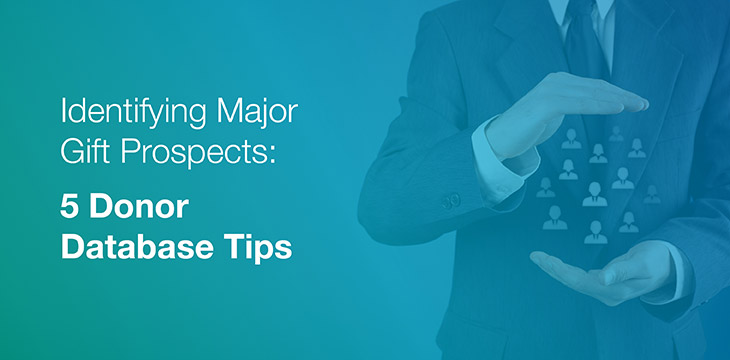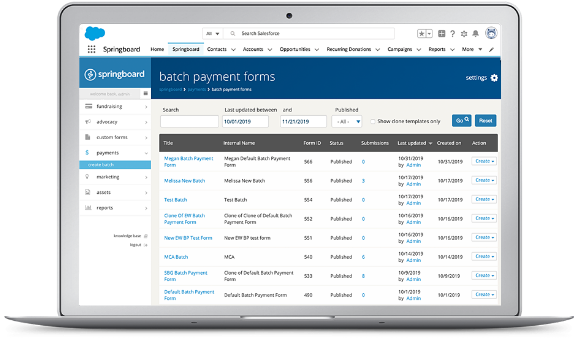5 Donor Database Tips | Identifying Your Major Gift Prospects

Nonprofits rely on all their supporters, from first-time donors to yearly volunteers to the donors who like and share your posts on social media. All support is meaningful and impactful!
But when it comes time to launch a major fundraising campaign,1 you need to bring in the big guns: major donors.
Every nonprofit defines major gifts differently, depending on their size and mission. No matter the actual gift amount, a major donation signifies a deep commitment to your nonprofit’s mission — they don’t just have the resources to support your nonprofit, they have the desire to do so.
While you could go outside your existing donor base to find major gift prospects, you’re better off starting with the supporters you already know are invested in your cause. An emotional connection is the most important element of major gift solicitation, so give yourself the advantage by identifying prospects who are already emotionally invested!
To find major gift prospects among your current donors, you can rely on information that you likely already have in your donor database and can indicate high giving potential:
- Involvement with your nonprofit and others.
- Employment status and business connections.
- Real estate ownership and political giving history.
- Organizational and institutional affiliations.
- Advocacy and special interests.
Ready to identify your next major gift within your donor database? Let’s get started!

One of the most reliable indicators of a solid major gift prospect is giving history. The emotional connection to charitable work is the difference between a prospect and a major donor.
So what should you look for in your database to identify that emotional connection?
Check for indicators such as:
- Past donations to your nonprofit. You’re not just looking for a past large donation. You’re looking for a pattern of above-average donations, especially automatically recurring contributions the donor set up through their bank.
- Participation in diverse fundraising methods. Simply sending a donation is easy, but participating in a crowdfunding campaign,2 a peer-to-peer fundraising campaign,3 or a VIP fundraising event experience takes more time and energy.
- Positions on nonprofit boards. Look to your own board first, but also check out the board at other nonprofits in your area of a similar size or with a similar mission. Major donors aren’t usually exclusive to one nonprofit at a time.
The common thread running through these factors is the level of commitment. Not every donor who gives a large donation is a good major gift prospect. You need to look for indications of donors who are willing to go out of their way, financially and otherwise, for a charitable cause like yours.
And the best part of this major gift prospect marker is that the information is so easy to find. You’re guaranteed to already be tracking donations and engagement with your nonprofit in your CRM,4 and websites like GuideStar and the Chronicle of Philanthropy make it easy to search for donors engaged in philanthropy with other organizations.

Of course, a major gift doesn’t just come from a personal attachment to nonprofit work and your cause in particular. Major donors have to have the means to make a meaningful contribution.
While it’s typically not possible to gain access to the financial standing of your donors, there are plenty of wealth indicators you can look to as a proxy.5
One of the most efficient is employment status, which you will either already have on file in your donor database or can easily find online through LinkedIn or a company website. Business owners, C-level executives, and board members are likely to have the means to contribute a major gift to your nonprofit.
Don’t stop there, though! Your donors’ business connections can tell you more than just their ability to donate a large gift. Also, keep an eye out for:
- Corporate philanthropy programs, such as matching gift or volunteer grant programs, that could increase donor’s average-sized gift to a major one.
- Decision-makers within HR, CSR, or executive departments who could help you establish a major partnership with a corporation.
- Connections to other prospects that don’t already donate to your nonprofit.
That last point is particularly important as you expand your major donor list. Prospects are much more likely to respond to a solicitation if they personally know the person reaching out to them.

Besides employment status, two other solid indicators of your donors’ wealth are real estate ownership and political giving history. People who have the resources to own large shares in real estate or support political campaigns with significant contributions likely also have the resources to support your nonprofit.
But real estate ownership and political contributions aren’t just wealth markers. In fact, these two markers, in particular, are also statistically linked to a philanthropic inclination.
According to DonorSearch’s research:5
- Those who own more than $2 million in real estate are 17 times more likely to donate to nonprofits.
- Those who donate more than $2,500 to a political cause are 14 times more likely to donate to nonprofits.
With online search tools like Zillow and the Federal Election Commission’s website, your nonprofit has access to this information. Or, if you don’t want to track this information down yourself, you could engage a prospect research firm to store it in your CRM for you.6
Beyond using these markers to judge your prospects’ wealth status and philanthropic disposition, you can also use them to actually guide your major gift strategy.
When you know the places (real estate) and causes (political contributions) your prospects are invested in, you will know which of your particular campaigns they will be most inclined to support.
Instead of soliciting a major gift from all of your prospects for any campaign, focus your efforts on those your donors would be most likely to care about based on the information you have.7
Your ROI will increase as you focus your time reaching out to prospects with a higher chance of a positive result. Plus, you’ll show your donors that you want their money to go toward a cause they feel passionate about and that you won’t bother them with generic solicitations.

Take a page from the university fundraising’s book.8 Just like your existing donors, alumni already have an emotional connection to their alma mater. University fundraisers know how to stoke that passion and turn it into donations for their university through:
- Hosting alumni events, such as networking lunches.
- Selling university merchandise.
- Focusing fundraising efforts on Founder’s Day.
You can take these same strategies and apply them to your major gift program, especially the first. When you host networking events that aren’t explicitly for fundraising, you give your nonprofit a chance to round out your major gift prospect profiles with attendees.
Take what you know about your donors’ organizational and institutional affiliations to put together specialized networking events. Maybe a large percentage of your donors attended the same university, belong to the same trade association, or maintain membership at the same cultural institutions.
As you find these connections, organize an event, online community, or discount program to encompass them.
Speaking of connections, you should also make special note of your donors’ educational background in your donor database. This information might come in handy later when you need to reach out to new prospects.

As we’ve established, the best major gift prospects are those who have demonstrated a passion for your organization, your cause, and the philanthropic spirit in general. They are the prospects that become long-term partners, not just one-time major donors.
Another great place to search for that spirit is in your donors’ advocacy efforts.
Look for donors who regularly:
- Sign petitions and share on social media.
- Attend special interest fundraisers, like breast cancer walks.9
- Participate in grassroots advocacy campaigns.
You’re not just looking for one of the above, you’re looking for many! A pattern of involvement in advocacy can point to the kind of passion that you’re looking for in a solid major gift prospect.
When investigating your donors’ advocacy efforts, keep in mind that they might not all be public. That’s why it’s important to build a relationship with your donors at events and online to gather the information organically.
Major donors can help your nonprofit make great strides in your next fundraising effort. Before you spend time and effort searching for these donors outside your organization, look within! Your next amazing partner could be right under your nose.
As you embark on your search, keep these additional resources close at hand:
- https://www.donorsearch.net/nonprofit-crowdfunding-platforms/
- https://www.onecause.com/peer-to-peer-fundraising-ultimate-guide/
- https://www.donorsearch.net/prospect-research-ultimate-guide/
- http://blog.clearviewcrm.com/fundraising/3-ways-to-increase-fundraising-results/
- https://www.donorsearch.net/university-fundraising/
- https://blog.fundly.com/breast-cancer-fundraising-ideas/
This informative post comes to the ClearView CRM blog from DonorSearch colleague Bill Tedesco, a well-known entrepreneur in the field of philanthropy with over 15 years of experience leading companies serving the fundraising profession. Bill has personally conducted original research to identify markers of philanthropy and has developed modeling and analytical products that use those markers to accurately predict future giving. Since 2007, Bill has been the founder, CEO and Managing Partner of DonorSearch. Bill Tedesco
